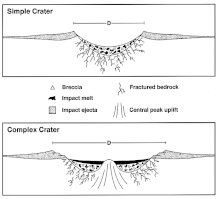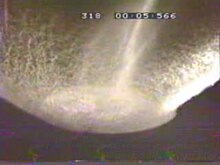Impact crater

An impact crater , also known as an impact crater , is a mostly approximately circular depression on the surface of an earth-like planet or a similar solid celestial body that is created by the impact - the impact - of another body such as an asteroid or a sufficiently large meteoroid . After the remains of such impactors found, the meteorites , one speaks of a meteorite crater .
In 1960, the American geophysicist Robert S. Dietz proposed the designation Astroblem ("star wound") for impact craters on earth , which has become common in German, partly also in French - for example Astroblème de Rochechouart-Chassenon .
General
All celestial bodies in the solar system with a solid surface have such craters. The moon is littered with impact craters. Impact craters are not as easy to recognize on Earth, whose surface is constantly being reshaped by erosion , sedimentation and geological activity as on celestial bodies that are not or less affected by them. An extreme example of this is Io , a satellite of Jupiter the size of the Earth's moon , whose surface is shaped by large tidal forces and very active volcanism and therefore has almost no impact craters.
| Formation of a crater with a central ring structure (5 images) |
|---|

|

|
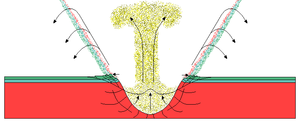
|

|
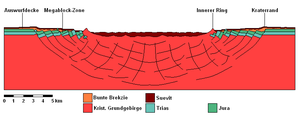
|
Emergence
Smaller meteoroids that are on a collision course with the earth burn up or burst in the earth's atmosphere and fall to the ground as small fragments. Larger objects, from a diameter of around 50 m, can penetrate the earth's atmosphere and reach the ground at speeds of 12 to 70 km per second. Hence, such impacts are called high speed impacts. Since the kinetic energy is converted into thermal energy in fractions of a second by strong compression of the material of both bodies , an explosion occurs. The surrounding material is blasted away, and regardless of the angle of impact, a circular depression is created like an explosion crater , at the edges of which the ejected material forms a wall. Around the crater there is ejected material called ejecta . These ejecta can create secondary craters around the primary crater.
Simple and complex craters
Smaller craters generally have a simple bowl-like shape and in this shape are called simple craters . From a certain size, which decreases in inverse proportion to the force of gravity on the respective celestial body and also depends on the target rock, complex craters arise . On the moon this limit diameter is 15 to 20 km, on the earth it is 2 to 4 km.
As the diameter of the crater increases, a central mountain initially forms . If the diameter is even larger, it becomes a central ring structure, and a multi-ring structure can also be created. In borderline cases, this can also contain a central mountain in the innermost ring. The reason for these structures of a complex crater is the springback of the crater floor after the impact of the impactor, which initially raises a central mountain in the middle of the crater, and the subsequent collapse of the unstable deep primary crater. These processes take place within a few minutes after the impact, in the area of the crater area already shattered by the shock wave. During the process, the crater diameter increases considerably.
Some lunar craters also show terrace-like depressions, which are created by the gradual yielding of the rock crust, as in a collapse basin.
Crater formation phases
Contact and compression
Upon impact, the contact and compression phase begins , during which a shock wave at supersonic speed propagates from the point of impact in two directions, namely into the impactor and into the target body, through the rock, compressing the material and thereby partially liquefying or evaporating it. At the shock wave front, crystalline minerals can be converted into phases of higher density due to the high pressures. For example, the common mineral quartz can be converted into the high pressure modification coesite or stishovite . Many other shock wave-induced changes occur as the shock wave passes through the impactor as well as the target body, and some of these changes can be used as diagnostic tools to determine whether or not a particular geological structure was created by an impact.
Excavation
This is followed by the so-called excavation phase , during which the smashed, liquid and gaseous material is thrown out of the crater. A large part of this ejecta (ejecta) is conveyed out of the crater in the form of a conical ejection curtain and forms an annular layer around the crater. An initially very hot cloud of smoke and dust forms over the crater, the condensing components of which can later partially rain back into the crater.
Modification and collapse
In most cases, the transient crater (transition crater ) that marks the end of the excavation phase is not stable. The modification phase begins , which causes the transient crater to collapse.
In simple craters , the original cavity is overlaid by breccia , ejecta and molten rock.
From a certain crater size, which depends on the planetary gravity, the modification and the collapse of the transition crater is much stronger. The resulting crater shape is called a complex crater . The collapse of the transient crater is driven by gravity and causes both the rise of the center of the crater and the inward collapse of the crater rim.
The central rise is not caused by elastic springback , but rather by the effort of a material with little or no strength to return to a state of equilibrium of gravity. This is the same process that causes the water to shoot up after an object falls into the water.
In this phase the crater enlarges considerably. Therefore, the transient and not the final crater is used as a measure of the energy and size of the impact event.
Large and well-known impact craters
Earth crater


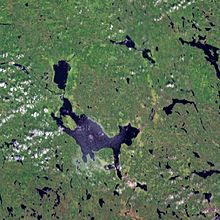
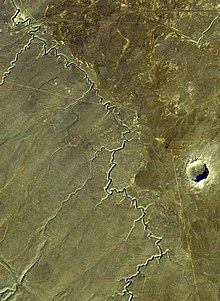
In addition to numerous smaller impact craters, over a hundred with a diameter of more than 5 km have been discovered on Earth . However, many of the impact structures found are not immediately recognizable as craters, as the crater rim has long been eroded ( e.g. Vredefort crater ) or the resulting depression has now been covered by younger sediments ( e.g. Chicxulub crater ). The structure of the Yarrabubba crater in Western Australia, estimated to be up to 70 km in diameter, is largely leveled on the surface. On the basis of uranium-lead dating , it was possible to determine their age at around 2.23 billion years (2229 ± 5 Ma). This makes Yarrabubba the oldest recognized meteorite impact structure on earth.
- The largest verified impact crater on earth is the Vredefort crater near the Witwatersrand Mountains near Vredefort in South Africa . According to various sources, the impact of a celestial body formed a crater up to 320 km long and 180 km wide 2 to 3.4 billion years ago, of which, however, only a remnant of up to 50 km is left.
- Another big impact crater is the Sudbury Basin to Ontario ( Canada ), which has about 200 to 250 km in diameter and is estimated 1.85 billion years old.
- The Chicxulub crater in Yucatán ( Mexico ) has a diameter of about 200 km. The impact of a celestial body there around 66 million years ago is said to have wiped out dinosaurs and many other species through global tsunamis , forest fires and the resulting pollution of the atmosphere .
- The Manicouagan crater in Quebec ( Canada ) was created by the impact of a celestial body from about 214 million years ago. From the original 100 km diameter, only 72 km are left due to sediment deposits and erosion.
- Similar in size to the Manicouagan crater is the Popigai crater in northern Siberia, which is around 35 million years old and also has a diameter of around 100 km.
- The Siljan crater in Sweden , which was formed around 360 million years ago, is the largest impact crater in Europe with a diameter of at least 50 km .
- Two impact craters in Germany are the Nördlinger Ries in Bavaria, which is around 24 km in diameter and formed around 14.6 million years ago, and the Steinheim Basin in Baden-Württemberg, 40 km away . Both craters have a central mountain. It is assumed that the two craters were created by the same event (Ries event) (presumably by a double asteroid). The smaller asteroid formed the Steinheim Basin, the larger (diameter: 1 km) the Nördlinger Ries.
- The very well-known Barringer Crater (also simply called Meteor Crater ), which was formed only about 50,000 years ago, is only about 1.5 km in diameter and up to 170 m deep, is located in the desert of Arizona ( USA ). Due to the low level of erosion, it is in a well-preserved condition. It is a typical example of a simple crater without a central mountain.
- The Silverpit crater was discovered in the North Sea in 2001 and, although only 2.4 km in diameter, has a structure of concentric rings surrounding the crater that extend up to 10 km away. The origin of the crater, which is very unusual as a result, has not been adequately clarified, but an impact is assumed around 65 million years ago.
- In 2006 the Wilkesland crater was discovered under the Antarctic ice sheet. The crater has a diameter of almost 480 km and was probably formed around 250 million years ago. However, it has not yet been verified that it is an impact crater.
- Less than 5000 years ago, when the nickel-rich iron meteorite " Gebel Kamil " of the ataxite type hit the very well-preserved Kamil crater with a diameter of 45 m and a pronounced ray structure , in southwestern Egypt .
Further impact structures of the earth
- Bosumtwi in Ghana
- Chesapeake Bay in the USA
- Elgygytgyn in Northeast Siberia
- Red comb in Namibia
- Tswaing in South Africa
Craters of other heavenly bodies
- On the Earth-facing side of the moon , around 300,000 craters with a diameter of over 1 km are known. The larger ones up to about 100 km or 300 km are called ring mountains or whale plains . Even larger ones are assigned to the lunar basins. The largest lunar crater, Hertzsprung, measures 536 km in diameter ( see also: List of craters on the Earth's moon ).
- The South Pole Aitken Basin is the largest impact basin on the moon with a diameter of 2240 km and occupies a considerable part of its diameter.
- At 10,000 km × 8,000 km, the northern lowlands on Mars are the largest known impact structure in the solar system.
- Hellas Planitia is one of the largest impact basins on Mars with a diameter of 2100 km × 1600 km and is over 8 km deep ( see also: List of Mars craters ).
- With a diameter of 1550 km, Caloris Planitia is the largest impact basin on Mercury ( see also: List of Mercury Craters ).
- Valhalla is the largest impact structure on Jupiter's moon Callisto . It has a diameter of 600 km and is surrounded by concentric rings up to a distance of almost 3000 km.
- With a diameter of 767 km, Abisme is the largest crater on Saturn's moon Iapetus
- With a diameter of 505 km, Rheasilvia is the largest crater on the asteroid Vesta .
- Mamaldi is the largest crater on Saturn's moon Rhea with a diameter of 480 km .
- With a diameter of 445 km, Odysseus is the largest crater on Saturn's moon Tethys .
- With a diameter of 392 km, Menrva is the largest crater on Saturn's moon Titan .
- With a diameter of 350 km, Evander is the largest crater on Saturn's moon Dione .
- With a diameter of 343 km, Epigeus is the largest crater on Jupiter's moon Ganymede .
- With a diameter of 326 km, Gertrude is the largest known crater on the Uranus moon Titania .
- With a diameter of 280 km, Kerwan is the largest crater on the dwarf planet Ceres .
- With a diameter of 270 km, Mead is the largest crater on Venus ( see also: List of Venus Craters ).
- With a diameter of 208 km, Wokolo is the largest known crater on the Uranus moon Umbriel .
- With a diameter of 206 km, Hamlet is the largest known crater on the Uranus moon Oberon .
- With a diameter of 255 × 230 km, Pharos is the largest crater on the Neptune moon Proteus .
- With a diameter of about 130 km, Herschel is the largest crater on Saturn's moon Mimas . It is up to 10 km deep. The impact almost destroyed the 400 km long moon.
- Jason is the largest crater on Saturn's moon Phoebe with a diameter of 101 km .
- With a diameter of about 100 km, Pan is the largest crater on Jupiter's moon Amalthea .
- With a diameter of 45 km, Lob is the largest known crater on the Uranus moon Puck .
- With a diameter of about 40 km, Zethus is the largest crater on Jupiter's moon Thebe .
- With a diameter of 10 km, Himeros is the largest crater on the asteroid Eros , which measures only 11 × 34 km and is probably not a monolith.
- Stickney is the largest crater on the Martian moon Phobos with a diameter of 9 km .
See also
literature
- Erwin Rutte: land of new units - in the footsteps of former meteorite impacts in Central and Eastern Bavaria. Univ.Verl., Regensburg 2003, ISBN 3-930480-77-8
- Julius Kavasch: Ries meteorite crater - a geological guide. Auer, Donauwörth 2005, ISBN 3-403-00663-8
- Christian Köberl , Francisca C. Martínez-Ruis: Impact markers in the stratigraphic record. Springer, Berlin 2003, ISBN 3-540-00630-3
- Christian Köberl, Wolf U. Reimold: Meteorite Impact Structures - An Introduction to Impact Crater Studies. Springer Berlin 2006, ISBN 3-540-23209-5
- C. Wylie Poag, (et al.): The Chesapeake Bay crater - geology and geophysics of a Late Eocene submarine impact structure. Springer Berlin 2004, ISBN 3-540-40441-4
- Paul Hodge: Meteorite craters and impact structures of the earth. Cambridge Univ. Press, Cambridge 1994, ISBN 0-521-36092-7
- Kevin Evans: The sedimentary record of meteorite impacts. Geol. Soc. of America, Boulder 2008, ISBN 978-0-8137-2437-9
- O. Richard Norton, Lawrence A. Chitwood: Field guide to meteors and meteorites. Springer, London 2008, ISBN 978-1-84800-156-5
- Isidore Adler: The analysis of extraterrestrial materials. Wiley New York 1986, ISBN 0-471-87880-4
- Roald A. Tagle-Berdan: Platinum group elements in meteorites and rocks of earthly impact craters - identification of impact bodies. Diss. Humboldt-Univ., Berlin 2004
- André J Dunford: Discovery and investigation of possible meteorite impact structures in North Africa - applications of remote sensing and numerical modeling. Dipl. Arb., Univ. Vienna, Vienna 2008
Web links
- Mineral Atlas: Impact - geology, impacts, known craters, etc.
- A stray field made up of impact craters from "Adventure Astronomy"
- Geological Survey of Canada database The Earth Impact Database
- List of all known terrestrial impact craters (English)
- The largest meteorite craters - with pictures and map display (Bayerischer Rundfunk)
- Online program to calculate the effects of impacts (English)
- Impact Craters The Lunar and Planetary Institute
Individual evidence
- ↑ Bevan M. French: Traces of Catastrophe - A Handbook of shock-metamorphic effects in terrestrial meteorite impact structures Lunar and Planetary Inst., Houston 1998 pdf online, 19.7 MB lpi.usra.edu, accessed on February 17, 2011
- ^ Christian Koeberl: Mineralogical and geochemical aspects of impact craters. Mineralogical magazines; October 2002; v. 66; no. 5; p. 745-768; doi : 10.1180 / 0026461026650059 Abstract
- ^ Christian Koeberl: Remote sensing studies of impact craters - how to be sure? CR Geoscience 336 (2004) 959-961, pdf accessed online on February 17, 2011
- ^ Morphodynamics of Planetary Impact Craters. Pp. 157-201 in: Hiroaki Katsuragi: Physics of soft impact and cratering. Springer, Tokyo 2016, ISBN 978-4-431-55647-3 .
- ↑ a b Erickson, TM, Kirkland, CL, Timms, NE et al. Precise radiometric age establishes Yarrabubba, Western Australia, as Earth's oldest recognized meteorite impact structure. Nat Commun 11, 300 (2020) DOI: 10.1038 / s41467-019-13985-7
- ↑ Johannes Baier: On the origin and importance of the Ries ejection products for the impact mechanism. In: Annual reports and communications from the Upper Rhine Geological Association. 91, 2009, pp. 9-29, doi : 10.1127 / jmogv / 91/2009/9 .
- ^ Moon: Crater, craters. In the Gazetteer of Planetary Nomenclature of the IAU (WGPSN) / USGS . Retrieved June 13, 2017
